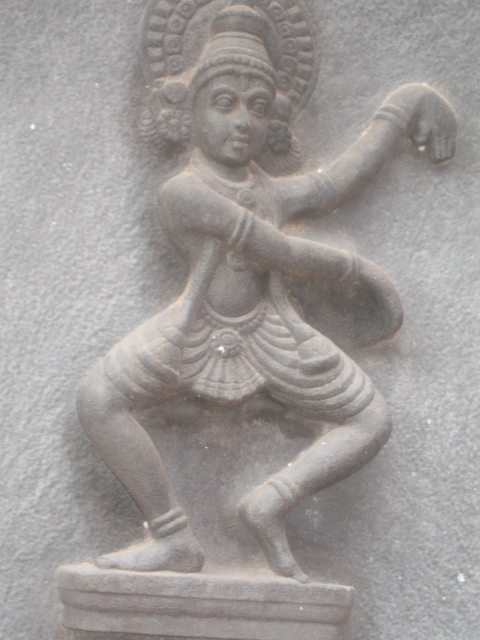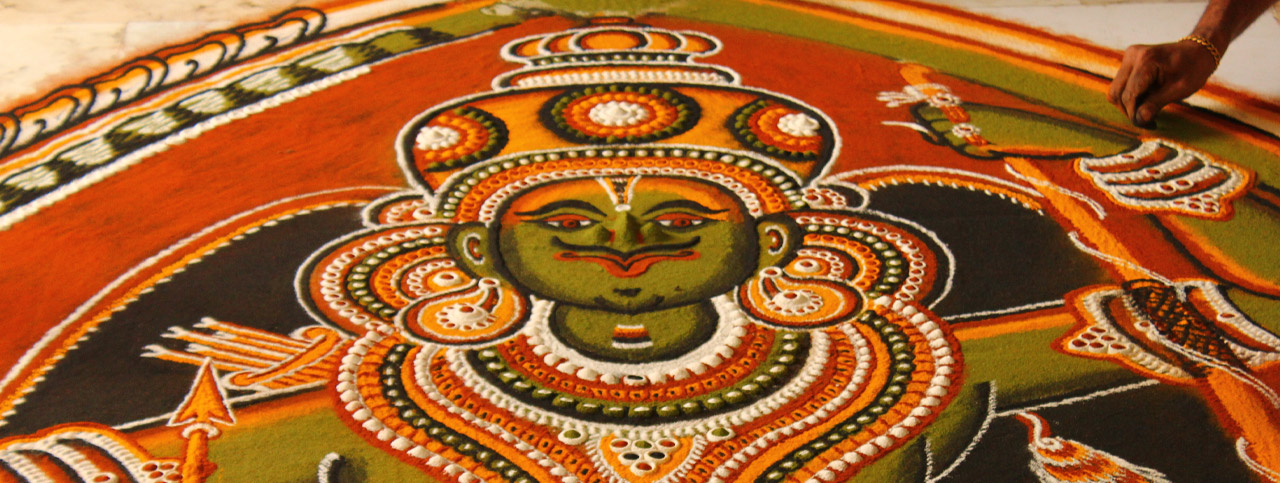From Temple To The Stage
Over 2,000 years ago Bharatha Muni wrote the NATYASASTRA [The Science of Acting], which became the academic guideline for classical dance, drama, music, costumes, make-up and the visual arts of India.

The Kathakali characters were inspired by the stunning sculptures of the temples depicting the gods and goddesses of the Ramayanan and the Mahabharatha. Kathakali also draws its inspiration from the temple rituals and earlier forms of classical drama to include Kootha, Koodiyattam, Krishnanattam and various folk arts.
The ancient art of Kalamuzhthu – sacred powder paintings depicting the gods and goddesses – have visual links with the costumes of Kathakali and the other temple art forms.

Kalamuzhuthu by Kalamandalam Haridas
The symbolic stories were memorised by the Brahmin [Namboodiri] priests then passed, unchanged, to the next generation, ensuring that the spiritual meaning was preserved.
Although Kings ruled the area, the Namboodiris had power, played a vital role in protecting these stories, education, law and spiritual development. As the Brahmins travelled and settled in various parts of India their stories and culture went with them.
After hundreds of years these sacred stories were performed in the temple forecourt for the whole community to experience how their ancestors lived, their aspirations and the spiritual development by which they evolved.
Kootha
Kootha was one of the fist art forms to emerge from the inner sanctum of the temple thousands of years ago.
It is a solo classical art, performed exclusively for the Chakyar community.
Kootha is a satire using wit and humour to tell stories from the Hindu epics interspersed with political situations, protest and injustice.
The story teller is known as a Chakyar.
The sacred stories had been locked inside the inaccessible inner sanctum of the temple for centuries experienced only by the priests.
Kootha made an incredible leap when ritual took its first steps into drama and paved the way for the dances and dramas of India to proceed.

Koodiyattam

2,000 years ago Koodiyattam, meaning "dancing together", emerged. It is the oldest surviving Sanskrit drama on earth, based in Kerala and has the status of a world heritage.
Koodiyattam involves elements of temple ritual, chanting in Sanskrit and acting accompanied by drummers. As the story telling element evolved the performing techniques develop to incorporate emotion, characters and an elaborate sign language called Mudras.
The Mudras began approximately 6,000 years ago as a system of signs to help the priests remember the Vedas called Veda Mudras. These developed further into the temple rituals approximately 4,000 years ago and began to represent words or objects used by the priests and called Puja Mudras. At this stage there was no performance and no audience.
It was only when the arts were accepted as a pathway to divinity that the Mudras became part of a dramatic language approximately 2,000 years ago and known as the language of the gods. Koodyattam perfected a ceremonial style of storytelling and made the revolutionary cross-over from ritual to drama.

